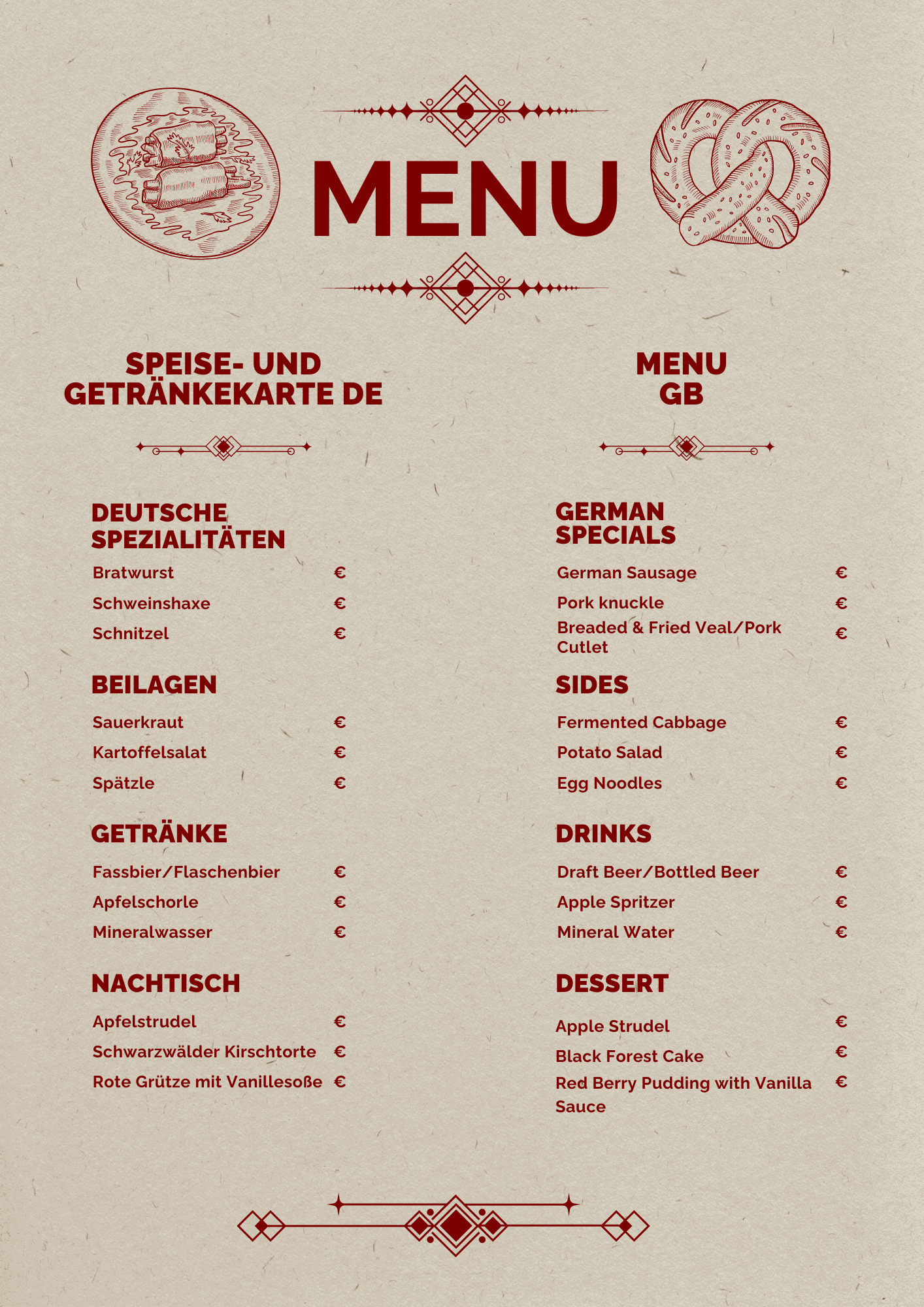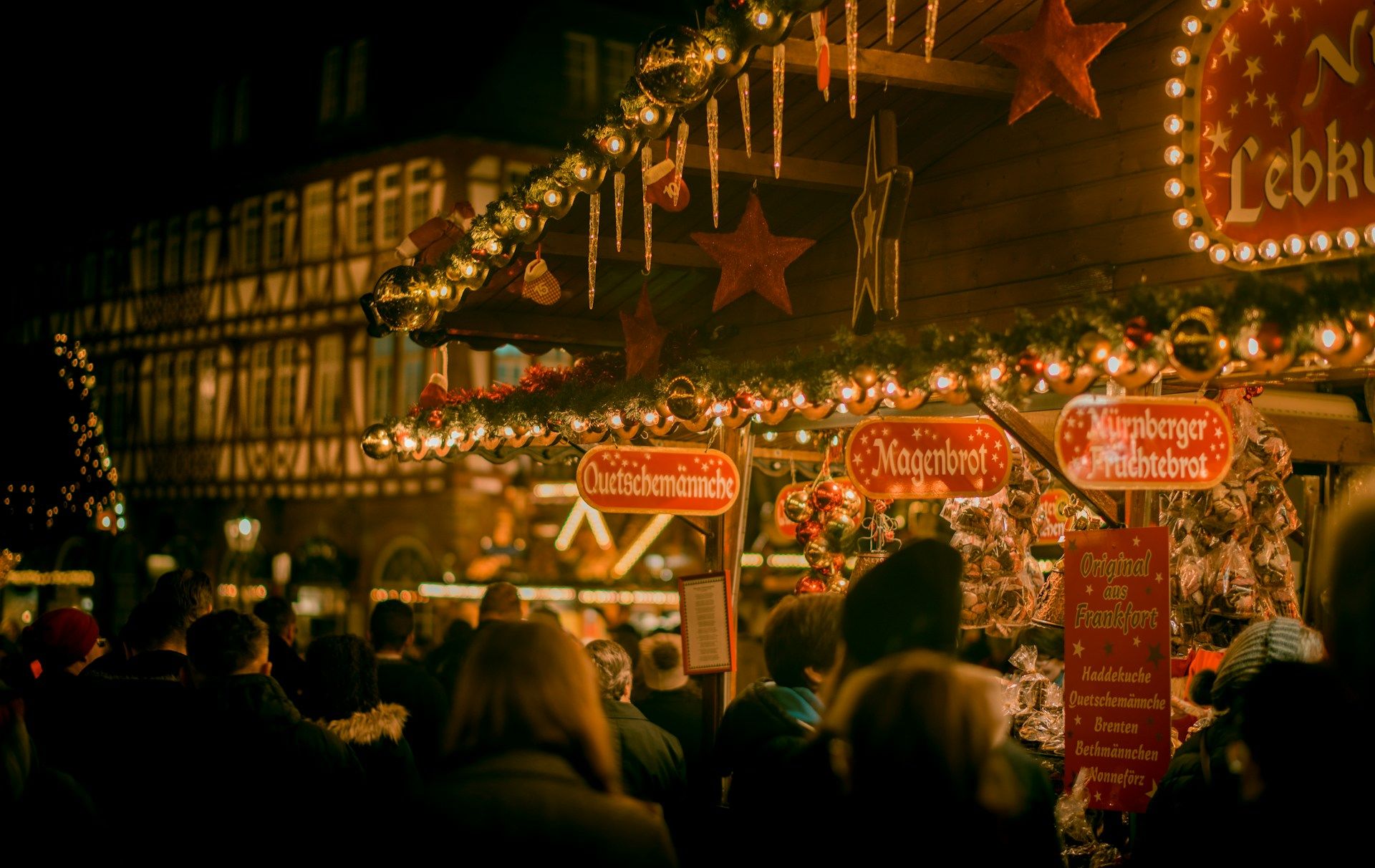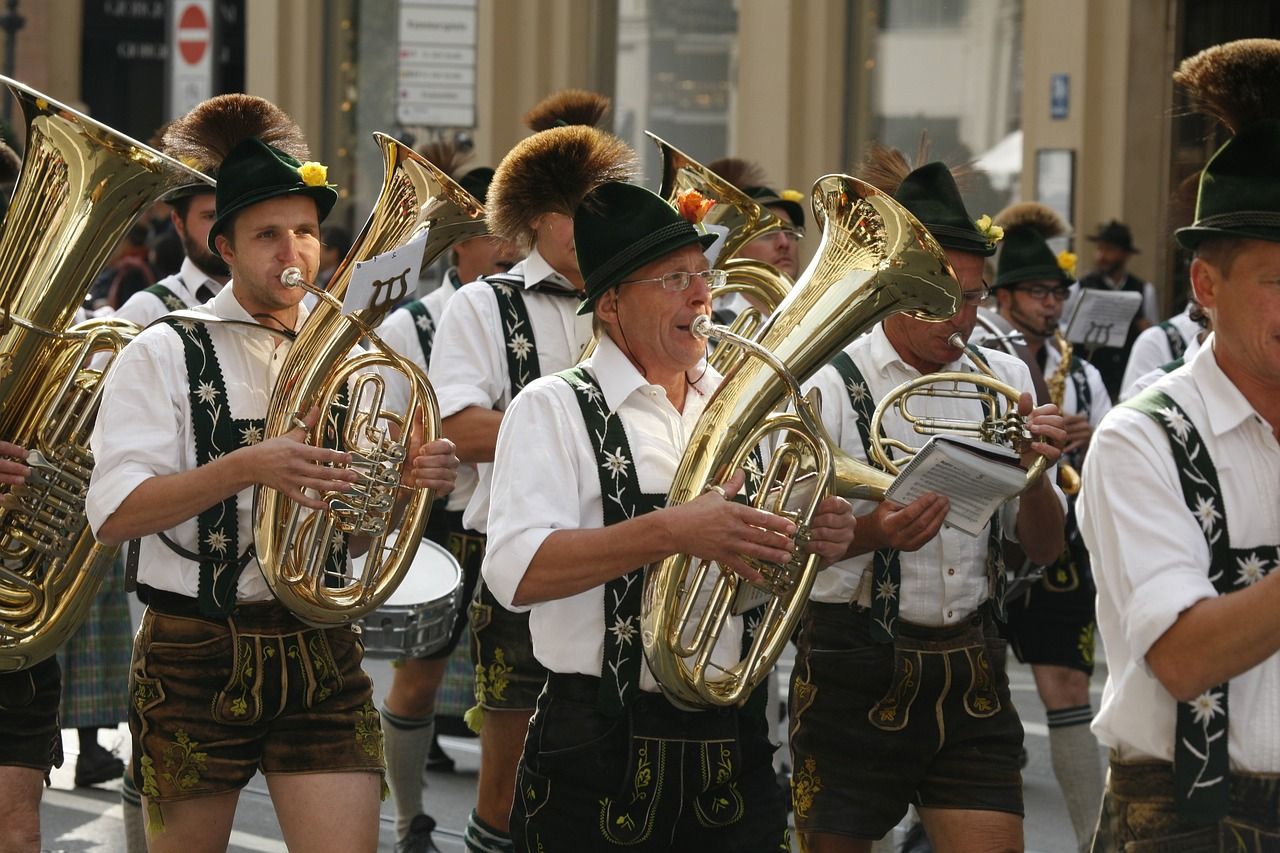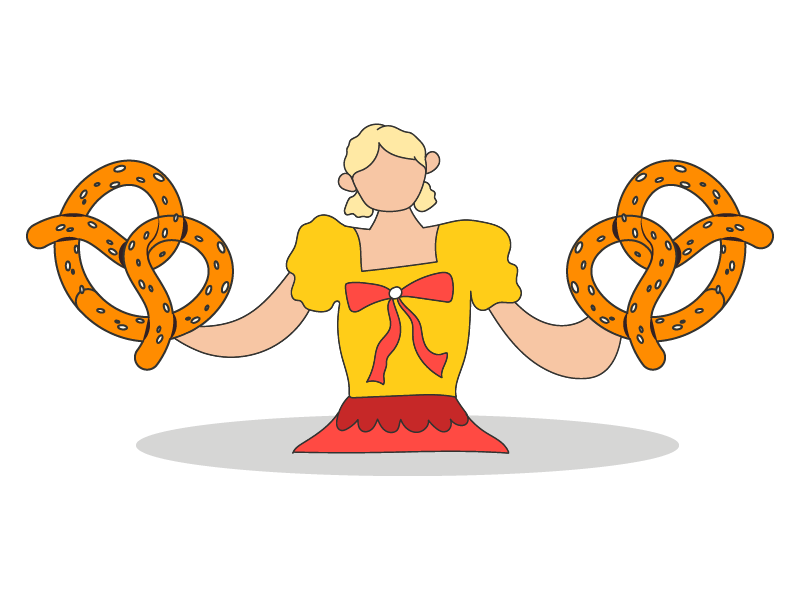Some common stereotypes about Germans include their love for beer, their reputation for being hardworking and punctual, and their affinity for cars (Audi, BMW, Mercedes-Benz, Volkswagen, and Porsche are manufactured here so that’s kind of a given). 😊
But there’s so much more to explore about German culture and way of life, and we’re here to take you on a tour. Before we do so, here are some quick facts about Germany:
But before we do so, here are some quick facts about Germany:
Germany: Quick Facts
- Germany has a population of approximately 84.6 million people.
- Germany is a federal parliamentary republic and comprises 16 federal states. Consequently, cultural characteristics are shaped by its different regions and cities.
- The native language and the most spoken language is German.
- Germany’s capital is Berlin. Other major cities include Hamburg, Munich, and Cologne.
Table of Contents
Language
When we think of a country’s culture, language is often one of the first things that comes to mind. As you may have guessed it, German is the primary language spoken in Germany, spoken by 95% of the population.
The German language is known for its long words (the longest is 79 letters) that are a result of joining nouns together. The alphabet consists of 26 Latin alphabet letters, plus its characteristic umlauts (ä, ö, and ü).

Study at GISMA University of Applied Sciences
Be one step ahead with a globally recognised college in Germany!
While there are regional German dialects like Bavarian and Saxon, the German state officially recognizes four minority languages:
- Upper and Lower Sorbian
- Romani
- Danish
- North and Saterland Frisian
Apart from minority languages, you’ll hear plenty of other languages spoken by the various communities with a migrant background. Plenty of people in Germany speak Turkish, Kurdish, Ukrainian, Russian, Arabic, Romanian, or Albanian as their first language.
Religion
Everyone can freely practice their faith in Germany, as this is guaranteed by Article 4 of the Basic Law for the Federal Republic of Germany.
According to a 2024 IPSOS survey, Christianity is the predominant faith, with 47% of the population identifying with this religion. Within this religion, around 20% of the respondents identified with the Catholic church and 24% with the Protestant or Evangelical church.
A significant portion of the population—35%—identify as having no religion or describe themselves as agnostic, while 9% percent preferred not to disclose. At 4%, Islam is the second-largest religion in Germany. The remaining 5% belong to smaller religious groups in the country.
While religious affiliation is declining, religious traditions and practices shape Germany to this day. You’ll notice religious influence the most during holidays like Christmas, Easter, Pentecost, etc.
Cuisine & Food

Traditional German cuisine is all about hearty and comforting meals. Specialties vary regionally, but succulent meats such as pork and veal are often the star.
Some typical German meat dishes include Bratwurst (a type of sausage), Schweinshaxe, (pork knuckle), Schnitzel, and Frikadellen (German meatballs). These are often paired with sides such as a potato salad, fermented cabbage, or Spaetzle (soft egg noodles).
For depth and flavor, these classic dishes incorporate cabbage, dairy products, and different spices and herbs such as cayenne pepper and thyme. Rich gravies and sauces such as the Rahmsoße (Rahm Sauce) elevate them even more. Beer often plays a role in cooking to enhance the taste of dishes like the beer-marinated Sauerbraten.

And let’s not forget the country’s love affair with bread and pretzels—they’re one of the food items Germans miss the most when they travel abroad. There are nearly 10,000 master bakeries across the country. All you have to do is follow the delicious scent of freshly baked rye bread (Roggenbrot), whole wheat rye bread (Vollkornbrot), rolls (Brötchen), or small pastries (Kleingebäck) to find them.
There are plenty of delicious desserts you can find in Germany as well. Sweet delights such as the Schwarzwälder Kirschtorte (Black Forest cake), Apfelstrudel (apple strudel), Lebkuchen (gingerbread-like cookies), and Stollen (Christmas fruit-bread) are a must-try!
German Drinking Culture
Beer is the undisputed king of beverages in Germany. There are, after all, entire festivals dedicated to it. To put it in perspective, visitors consumed a staggering 6.5 million liters in just 18 days of the Oktoberfest beer festival of 2023. You can choose from countless varieties of the drink, from pilsners to wheat beers.
The country also has a long tradition of wine production, particularly in regions like the Mosel Valley, best known for its Rieslings. If you’re into spirits, you’ve likely heard of Jägermeister, the famous German herbal liqueur.
If you don’t drink alcohol, fret not. Most establishments offer non-alcoholic drinks, including the refreshing Apfelschorle, a mix of apple juice and sparkling water. There is also a considerable coffee culture around the country, especially in large cities where can find both quaint cafés and international chains.
Fashion and Clothing

Each region in Germany has its unique traditional costumes, such as Bavaria’s Lederhosen for men (leather trousers ending just above the knee) and the Dirndl dress for women (featuring a bodice, blouse, full skirt, and an apron). These traditional outfits are typically worn during carnivals and festivals.
In their day-to-day, Germans usually opt for casual and comfortable outfits. These can include the jeans and T-shirt combo or a casual dress paired with sneakers or some other comfortable footwear.
During winter, most like to layer with a sweater or hoodie and a thicker jacket. The casual dress code often extends to office wear, with most office dress codes being business casual in non-costumer-facing jobs.

Germans dress more formally and conservatively for important events and formal settings. These can include funerals, work dinners, weddings, business meetings, etc. The event and season will determine what to wear, but generally speaking, men wear suits and women wear skirt suits, pantsuits, or dresses.
Holidays and Traditions
There are nine public holidays celebrated nationwide in Germany. The majority are Christian celebrations that are observed by religious people (and enjoyed as a day off from the rest), but there are also some historical and cultural holidays as well.
- New Year’s Day (Neujahrstag). As in many countries, January 1st marks the new calendar year. Germans celebrate this day with fireworks, parties, and family gatherings. They wish each other “Frohes Neues (Jahr)!” (Happy New Year!).
- Good Friday (Karfreitag). This holiday is observed on the Friday before Easter Sunday to commemorate the crucifixion of Jesus Christ. In Germany, people attend church and spend their time in silent reflection.
- Easter Monday (Ostermontag). This is the day after Easter Sunday, known for family gatherings, Easter egg hunts, and festive meals.
- Labor Day (Tag der Arbeit). This holiday is celebrated each year on May 1st to honor workers’ rights. It is marked with demonstrations, rallies, and other public events.
- Ascension Day (Christi Himmelfahrt). 40 days after Easter Sunday marks Jesus Christ’s ascension into heaven, a holiday which is observed by Catholics through church services and family gatherings. This day also marks Father’s Day (Vatertag), celebrated by many German fathers by getting together for walks in nature while carrying handcarts (Bollerwagen) full of beer.
- Whit Monday (Pfingstmontag). Whit Monday is another Christian holiday, celebrated the day after Pentecost. Since it always falls on a Monday, many people take advantage of the long weekend to spend time with their families, usually enjoying picnics and other outdoor activities.
- Day of German Unity (Tag der Deutschen Einheit). On October 3rd each year, Germans celebrate the reunification of East and West Germany in 1990. This historical day is marked by patriotic events around the country, including a three-day festival in Berlin around Platz der Republik and the Brandenburg Gate.
- Christmas Day (Weihnachtstag). This Christian holiday falls on December 25th each year and is one of the most popular festivities in Germany, even among the non-religious. Germans usually spend the day with loved ones, exchanging gifts and eating delicious meals.
- Boxing Day (Zweiter Weihnachtstag). Translating as the second Christmas Day, the 26th of December is a day of relaxation, recreation, and spending time with loved ones.
Additionally, you may stumble upon holidays that are only celebrated in specific states or regions. Some of them include Epiphany (Heilige Drei Könige), Corpus Christi (Fronleichnam), Reformation Day (Reformationstag), and All Saints’ Day (Allerheiligen).
Sports and Leisure
Germans absolutely love sports and outdoor activities. A 2017 DOSB survey estimates that there are around 90,000 sports clubs and 27.4 million club memberships in Germany. A significant portion of the population—about 33.2%—actively participates in such clubs.
Among sports, football (soccer) reigns supreme as the nation’s favorite, especially on a professional level. The German Bundesliga—the professional association football league—draws massive crowds and enthusiasm. However, basketball, handball, volleyball, tennis, ice hockey, and athletics are also quite popular.
Walking and hiking are other favorite pastimes, to the point that many foreigners poke fun at German people’s idea of a ‘short walk’. Plenty of people also enjoy cycling and skiing, thanks to the country’s beautiful landscapes and well-developed infrastructure.
Festivals and Celebrations

Whether it’s a traditional folk festival or a modern event, people in Germany love to come together to celebrate with music, good food, and dancing. Festivals frequently include live music performances, traditional cuisine, colorful parades, and busy street markets.
Here are some of the most popular festivals and events in Germany:
- Beethovenfest – Bonn. Beethovenfest in Bonn is an annual celebration of classical music. Ludwig van Beethoven’s birthplace honors the composer’s legacy with around 80 diverse events.
- Berlin International Film Festival (Berlinale) – Berlin. Another annual event, Berlinale is a major film festival that showcases around 200 films of different genres and formats. It gathers film professionals and enthusiasts from all over the world.
- Cannstatter Volksfest (Stuttgart Beer Festival) – Stuttgart. This three-week folk festival in Stuttgart is one of Germany’s largest, taking place around late September until mid-October. There are a lot of beer tents, a spectacular parade on the first Sunday of the festival, trader’s market stalls, live music, and more.
- Carnivals (Karneval/Fasching) – nationwide. Carnivals are a long-held tradition in Germany, dating back to the Middle Ages. The festivities were later adopted into the church calendar to celebrate six weeks before Easter, before the period of fasting (Lent). You’ll find these festivities across each region of Germany, each with its unique costumes, colorful parades, and traditions. The Rosenmontag parade in Cologne is one of the largest and most popular carnival celebrations.
- Christmas Markets (Weihnachtsmärkte) – nationwide. Very few countries do Christmas markets like Germany. Taking place each year from the end of November to the last days prior to Christmas, the colorful stalls are famous for their festive ambiance, delicious Glühwein (mulled wine), roasted almonds, Bratwurst, and more. Many of them sell handicrafts that make for lovely gifts. Some of the most-visited markets are those in Nuremberg, Dresden, and Munich.
- Easter Markets (Ostermärkte) – nationwide. A week or two leading up to Easter, markets open nationwide to welcome the holiday with handmade crafts, Easter eggs and candy, flowers, and more. Berlin’s Easter Market at Alexanderplatz and Stuttgart’s Easter Market at Schlossplatz are popular destinations
- Oktoberfest – Munich. Indisputably the most popular even in Germany, the Oktoberfest in Munich is the largest beer festival in the world. Millions of visitors each year visit the festival for the local beer, Bavarian cuisine, and carnival rides.
- Reeperbahn Festival – Hamburg. One of Europe’s largest club festivals, the Reeperbahn Festival in Hamburg is the place to be for music acts, conferences, and art exhibitions combined into one.
- Rhein in Flammen (Rhine in Flames) – multiple locations. This series of fireworks festivals offers spectacular displays against panoramic backdrops in multiple locations along the Rhine River.
- Walpurgis Night (Walpurgisnacht) – Harz Mountains. Each year on the 30th of April, people dress up in costumes, light up bonfires, and make loud noises to welcome spring. It is a night rooted in pagan folklore and tradition.
German Social Etiquette
From knowing how to politely greet elders to choosing an appropriate gift, it’s nice to know the dos and don’ts of a new culture. Here are some tips on social etiquette in Germany:
Greetings and Politeness
- In Germany, a friendly “Hallo” (hello, informal) or “Guten Tag” (hello, formal) is customary when entering a shop, office, or someone’s home to acknowledge the other person.
- However, if you don’t really know the person, small talk is not necessary, as Germans are not very fond of it.
- When you’re leaving a place, it’s nice to say “Auf Wiedersehen” (formal) or “Tschüss” (informal) for goodbye.
- Addressing people correctly is equally important in social interactions. The language offers two forms of “you”: “du” and “Sie.”
- “Du” is informal, used to address friends and family, while
- “Sie” is the formal option, used with strangers or to convey respect.
- Using “Bitte” (please) when making a request and “Danke” (thank you) when expressing gratitude is expected and appreciated in everyday exchanges.
Check out our Guide to Learning German for other useful phrases and daily expressions.
German Work Culture
German work culture is all about precision, efficiency, and maintaining a professional attitude. The country has a reputation for strong work ethic and fairly strict workplaces, however, it also has some of the best work-life balance and social security policies among European countries.
Germans set clear boundaries between their work and home lives. They even have a special word—“Feierabend”—to denote the end of the work day.
On average, people in Germany work around 40.5 hours per week, which is somewhere in the middle compared to other European countries. They treasure their personal time, making use of generous vacation days. All employees in Germany working a 5-day week are entitled to a minimum of 20 vacation days per year.
Gift-Giving
Gift-giving is common in Germany, especially on occasions such as birthdays, Christmas, and other special events.
Gifts are usually wrapped with a nice wrapping paper and a bow. As for the actual gifts, German’s love for practicality comes through. Most people prefer receiving something modest and thoughtful rather than an extravagant gift.
Flowers are a popular and well-received gift in Germany, especially when visiting someone’s home. Other ‘safe’ gifts include chocolates, alcoholic beverages, and food delicacies (especially if you’re coming back from traveling).
You still need to be mindful of the recipient and your personal relationship to them, just like in other countries.
Dining Etiquette & Tipping
Dining out is somewhat expensive in Germany, so many only go out to eat once in a while rather than every day. Most people prepare food and eat in the comfort of their homes. If you’re eating with someone, you typically kick off the meal with a “Guten Appetit” (enjoy your meal).
If you are invited to someone’s home for dinner, it’s polite to wait for the host to start eating before you do. Meals are usually family-style, so you can expect to share some courses and pass around plates. After finishing your meal, a simple “Danke” (thank you) is enough to show your appreciation.
As for dining out, you might wait to be seated in fancier places, but in casual spots, feel free to choose your table. When you’re ready to order, a raised hand or “Entschuldigung” (excuse me) gets the server’s attention. To pay, both cash and cards work, but cash is more widely accepted. Tipping is appreciated but not mandatory; rounding up or leaving an extra 5-10% is common for good service.
Weddings
If you’re invited to a wedding in Germany, be sure to RSVP promptly when you get the invite–it’s a big help for the couple planning it.
When it comes to wedding guest outfits, Germans lean towards formal attire. Women often go for dresses (any color but white), and men typically wear suits. If you’ve been to a U.S. wedding, the style is quite similar.
The most common gift for newlyweds in Germany is cash, often put in a nice envelope or creative packaging (look up “Geldgeschenke Hochzeit” for ideas).
During the festivities, embrace the fun by raising your glass with a cheerful “Prost!” for toasts. And don’t be shy to hit the dance floor–Germans love to dance at weddings. When the festivities wind down, take a moment to personally thank the couple for inviting you.
Funerals
Funerals are dignified (and highly regulated) rituals in Germany. Depending on the deceased’s and their family’s wishes, the funeral follows Christian or secular traditions.
Christian funerals include a church service, often with an open casket, followed by burial or cremation. Secular funerals follow similar procedures, without the religious elements.
Germans wear dark and conservative clothing at funerals. If you want to offer condolences to the grieving family, saying “Mein Beileid” (my condolences) is appropriate.
You can also bring flowers such as a wreath or a bouquet to show your sympathy. During the service, maintain a quiet and respectful demeanor, ensuring your phone is on silent mode.
Behavior in Public Spaces
Here are some cultural aspects to consider when you’re out in public in Germany:
- Strong sense of community. Germans have a strong sense of community and look out for one another. For instance, if you spot a lost item hanging from a tree, it was probably a thoughtful gesture by someone who put it there so its owner could see it.
- Public transportation. When using public transportation, make sure to queue up and give others room to get out before boarding. Always buy a ticket and validate it before boarding trams, buses, or trains. Ticket inspectors will occasionally check them; if it’s not validated or you don’t have it with you, you’ll be fined.
- Priority seats are reserved for those in need (elderly, pregnant, disabled, and injured persons, so it’s expected to offer them your seat.
- Order. In public spaces and queues, Germans value order and quiet. Whether you’re waiting for the train or you’re in the library, try to keep noise levels down and respect personal space. This is especially important in residential areas. In fact, Germans have specific quiet hours to ensure peaceful living (on weekdays and Saturdays from 10 pm until 6/7 am and on Sundays for the whole day).
- Recycling. People in Germany are very environmentally-conscious and recycling is taken very seriously (there are fines if you sort trash improperly!). Each household and public space has specific bins for paper, plastic, glass, and more, so remember to sort trash and recycle responsibly.
- Supermarket checkouts. Navigating supermarket checkouts in Germany is like a mini workout for your packing skills. Unlike some countries, there’s no dedicated bagger, so you’ll need to pack your items quickly into your bag or reusable totes after they’re scanned (plastic bags are banned; other bags are available for purchase). Payment options include cash and cards.
Literature
Although not as popular in the age of technology, reading is still a cherished pastime for many Germans. In 2022 alone, 64,000 new book titles were published in Germany. The country is home to the world’s largest book fair, the Frankfurt Book Fair, which attracts publishers and literary enthusiasts from all over the world.
Plus, did you know the first-ever magazine was printed in German? The “Erbauliche Monaths-Unterredungen” was issued monthly from 1663 to 1668.
German and German-speaking authors have also gifted us with timeless classics such as Goethe’s “Faust”, Kafka’s “The Metamorphosis”, Mann’s “The Magic Mountain”, and Hesse’s “Siddhartha”, to name a few.
Philosophy
Some of the world’s most influential thinkers and philosophical discourses originated in Germany. Immanuel Kant (1724-1804) was one of the central figures of the Age of Enlightenment, whose ideas centered around transcendental idealism and reason as the source of human morality.
Later on in the 19th century, Georg Wilhelm Friedrich Hegel was a prominent thinker of German Idealism, known for adopting a triad philosophy system: the Science of Logic, the Philosophy of Nature, and the Philosophy of Spirit. In the mid-1840s, Friedrich Engels and Karl Marx authored several works in which they developed their theories of historical materialism and the critique of capitalism.
In the 20th century, the Frankfurt School drew from Marxism, critical theory, and psychoanalysis to further critique the capitalist system & the change brought by it. Martin Heidegger was another important figure of this period, best known for his theories on hermeneutics and existentialism.
Music

Traditional German music and dance vary from region to region, but two prominent genres include Volksmusik (literally: music of the people) and Oompah. You’ll be able to enjoy this type of music at most folk festivals (including Oktoberfest) and fairs.
Volksmusik is typically associated with the Alpine regions of Germany, also known as the Bavarian Alps. Songs often have lyrics pronounced in thick regional dialects, accompanied by instruments such as guitars, mandolins, accordions, and flutes.
Oompah music, on the other hand, is characterized by a steady beat (Oompah being the word describing the sound) of a deep brass instrument such as clarinet, trombone, trumpet, or tuba, together with other instruments such as accordions, drums, and clarinets.
Schlager is another “typisch Deutsch” music style that, perhaps due to its popularity, is often considered as folk music. However, its simple and catchy melodies and lyrics are more representative of pop music. It is a festival favorite, as everyone gets wasted and belts out the lyrics, despite many Germans finding it cheesy.
Traditional music certainly holds a special place in German culture, but classical music from the country’s legendary composers truly changed musical history. Germany was home to composers like Beethoven, Bach, Schumann, and Strauss, to name a few. You can listen to performances of their work on the many concert stages and opera houses across the country, such as the Berlin Philharmonic or the Elbphilharmonie in Hamburg.
In their day-to-day, Germans listen to a wide range of modern music genres, from electronic beats and catchy pop tunes to gritty rock anthems. Each city has its own music scene. Berlin, for example, is known for its edgy techno music culture and clubs.
Art

German art has developed alongside the history of the nation. Each piece of work from periods ranging from the Middle Ages to Renaissance, Romanticism, and Modern Art Neo-Expressionism has left traces of the past.
During the 15th and 16th centuries, the German Renaissance produced some of the most influential artwork and artists. Albrecht Dürer is considered the greatest German Renaissance artist. He was known for exploring and perfecting various forms of art, including oil painting, printmaking, engraving, and writing.
In the late 18th and early 19th centuries, German Romanticism reflected an attempt at escaping an increasingly industrialized world. Paintings often portrayed natural landscapes and incorporated mystical elements. It’s impossible to talk about this period without thinking of masterpieces such as Caspar David Friedrich’s “Wanderer above the Sea of Fog”.
Germany is also home to influential art movements like the Bauhaus, Expressionism, and Dadaism. These revolutionized design, challenged artistic norms, and left a lasting impact on the global art scene.
Here are some of the most famous paintings by German artists:
- “Christ Among the Doctors” – Albrecht Dürer (1506)
- “Rhinocerus” – Albrecht Dürer (1515)
- “The Ambassadors” – Hans Holbein the Younger (1533)
- “Wanderer above the Sea of Fog” – Caspar David Friedrich (1818)
- “The Monk by the Sea” – Caspar David Friedrich (1818)
- “Street, Berlin” – Ernst Ludwig Kirchner (1913)
- “The Elephant Celebes” – Max Ernst (1921)
- “The War” – Otto Dix (1929-1932)
- “1024 Colours” – Gerhard Richter (1973)
Architecture

From ancient Roman structures to modernist architecture, Germany is a dream destination for architecture enthusiasts. There are 52 UNESCO-protected sites in Germany, many of which are architectural structures.
You’ll find several of these sites in Trier, Germany’s oldest city, founded around 16 BC during the reign of Roman Emperor Augustus. The Porta Nigra (city gate), Römerbrücke (Roman Bridge), and the Trier Imperial Baths are just a few of the Roman traces left in the city.
The later Romanesque style is seen in the sturdy structures of the many religious buildings of this period. The Speyer Cathedral is a perfect example and the largest remaining church of this architectural style.
Speaking of large cathedrals, the Cologne Cathedral is among the largest in Europe. The construction of this 157-meter (515 ft) tall Gothic architectural structure dates back to 1248, however, it took until 1880 for Germans to see its completion. Its twin towers and spires are typical of this style.
Gothic architecture is one of the most prevalent styles in many regions around the country. Brick Gothic is especially popular in the northern part of Germany, as seen in Lübeck’s Marienkirche (St. Mary’s Church) and the Holsten Gate. Timber-framed houses are another characteristic of this late-medieval style. There are more than 1,300 such houses in Quedlinburg, one of the many German towns that adopted this type of architecture.
The Renaissance inspired majestic castles and palaces like Heidelberg Castle and the Munich Residenz. The Baroque style also left behind remarkable buildings characterized by their beautiful frescoes. The Würzburg Residence and Dresden Zwinger’s complex are a must-see to explore this style.
Other Neo-classical, Modern, and Post-modern architectural structures harmoniously coexist with the ancient. Below, we have highlighted some buildings and structures that are a must-see in Germany:
- Reichstag Building – The building of the prior legislative government turned seat of the Bundestag is a mix of Renaissance, Neo-Renaissance, and Baroque/
- Elbphilharmonie – Must see for its flowing roof & vineyard-style halls (Postmodern architecture).
- The city of Rottenburg ob der Tauber – For postcard-worthy medieval architecture and half-timbered houses.
- Cologne Cathedral – This UNESCO World Heritage Site is a perfect example of Gothic architecture.
- Aachen Cathedral – This Roman catholic cathedral dating back to the year 805 is a mix of Carolingian, Romanesque, and Gothic styles.
- Unité d’Habitation of Berlin – Brutalist apartment building (1958) by the famous Swiss-French architect Le Corbusier.
- Berlin’s Museum Island – This amazing complex connecting five museum buildings is a treat for city planners (and all art enthusiasts).
- Würzburg Residence – This German Baroque-style palace is a feast for your eyes.
- Brandenburg Gate – This Neoclassical monument in Berlin was inside the border of the former Soviet sector during the Cold War. After the fall of the Berlin Wall, this former symbol of division now represented freedom and unity.
Join 262,114 students interested in studying in Germany
 Download a free copy of our "Essential Guide to Studying in Germany for Free", get regular emails sent to your inbox with helpful articles about studying in Germany, latest news, scholarships, study abroad opportunities and offers...
Download a free copy of our "Essential Guide to Studying in Germany for Free", get regular emails sent to your inbox with helpful articles about studying in Germany, latest news, scholarships, study abroad opportunities and offers...




